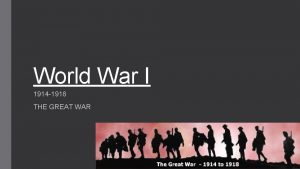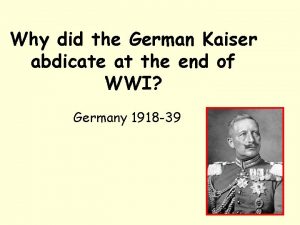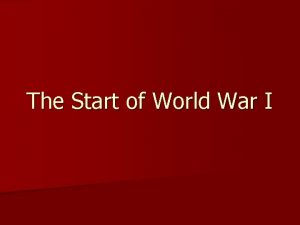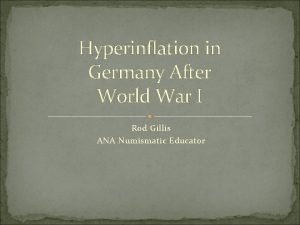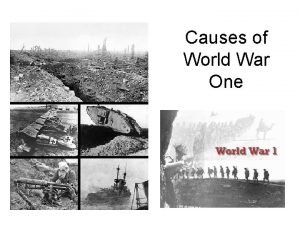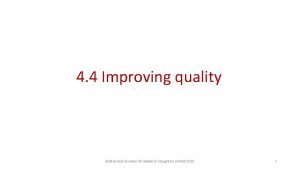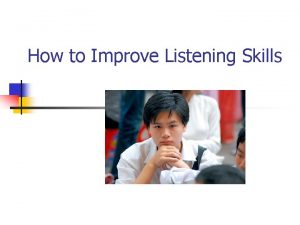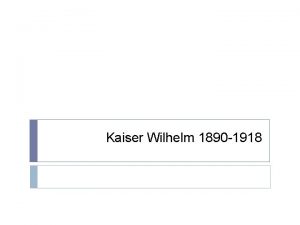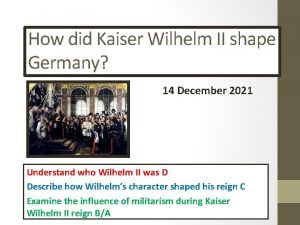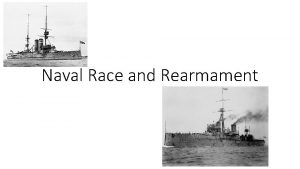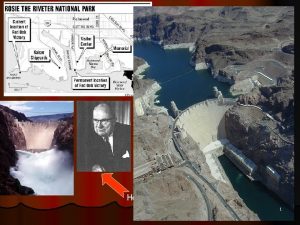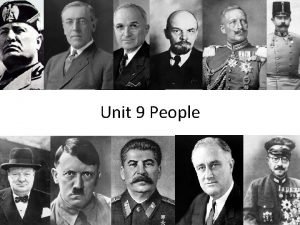Paper 1 Germany Kaiser Wilhelm and the difficulties









- Slides: 9

Paper 1: Germany

Kaiser Wilhelm and the difficulties of ruling Germany the growth of parliamentary government Kaiser had extensive powers : He could appoint and dismiss the Chancellor and his ministers, he decided what the Reichstag discussed. The Reichstag could discuss , amend and vote on new legislation (proposed by Kaiser’s government) The left-wing Social Democratic Party started gaining support and pushing for reforms. The Kaiser however appointed right-wing men into his government the influence of Prussian militarism Prussia was the most powerful of the 25 German States Prussia had a proud tradition of military strength (Franco-Prussian War) Military swore an oath of allegiance to the Kaiser Generals controlled foreign policy industrialisation By 1914 Germany was producing one third of the world’s electrical goods. Germany led the world in the chemical and steel industries Engineering firms Bosch and Siemens were known world wide Exports grew rapidly social reform and the growth of socialism Many workers were unhappy with low wages and poor working conditions Workers joined trade unions and organised strikes hoping to force the government to improve pay and working conditions. By 1914 over three million workers had joined trade unions The Social Democratic Party (SPD) became more popular amongst the workers with around one in three Germans voted for the SPD at the time. The party possessed key socialist beliefs such as that power and wealth should be shared equally amongst the people and they hoped that the Kaiser might allow the Reichstag to make more social reforms. Between 1898 and 1912 the Navy Laws were introduced which lead to a huge amount of money being spent on the expansion of the navy. The Kaiser wanted a large navy to help him take over more countries and protect those already in the German Empire. Taxes were increased and money was borrowed to pay for this. Germany would remain in debt for a very long time. the domestic importance of the Navy Laws

Impact of the First World War weariness The war deepened divisions in German society and the stresses led to the abdication of the Kaiser German workers bitter at restrictions placed on their earnings There was a huge gap between rich and poor 600, 000 widows, 2 million children without fathers Revolution October-November 1918 economic problems There were huge gaps between the living standards of the rich and the poor. The factory owners made vast fortunes from war whereas many German workers were bitter at the restrictions placed on their earnings. National income was about one-third of what it had been in 1913 Industrial production was about two-thirds of what it had been in 1913 War left 60, 000 widows and 2 million children without father. By 1925 the state was spending about one-third of its budget in war pentions. defeat Allies made strict demands: Kaiser had to abdicate Germany had to become a democracy The Treaty of Versailles was imposed: £ 6, 6000 million in reparations, no air force, war guilt clause, loss of colonies and territiory in Europe, limited armed forces, couldn’t unite with Austria or join league of nations the end of the monarchy The Allies offered peace in autumn 1918 but under strict conditions including Germany should become more democratic. The Kaiser refused so the sailors in northern Germany mutinied and took over the town of Kiel. The Socialists led uprisings of workers and soldiers in other German ports. In Bavaria an independent Socialist REPUBLIC was declared. On 9 November 1918 the Kaiser abdicated his throne. post-war problems The new government had to face all the problems that existed including political uncertainties, economic problems, a crisis in German society and a devastating outbreak of flu. Under the treaty of Versailles Germany was to pay the huge sum of £ 6, 600 million in annual instalments. In 1922, nothing was paid so French and Belgian troops invaded the Ruhr in attempt to take the money in the form of raw materials and goods. The Germans went on strike (the French killed over 100 workers in response) and the German currency collapsed.

Weimar democracy political change and unrest, 1919– 1923 March 1920 - The Kapp Putsch. Wolfgang Kapp gathered around 5000 men and attempted to take over the country and recapture lost territory. After only 100 hours as Germany’s leader he fled abroad. March 1920 – The Red Rising. After the Kapp Putsch workers in the industrial Ruhr stayed on strike. They took over several towns but the government put the rising down which led to the deaths of around 1000 workers. 1919 -1920. political assassinations. During this period there were over 350 political murders in Germany, mostly carried out by right-wing extremists. November 1923 - Hitler attempted the Munich Putsch with around 2000 supporters. Three Policemen and 16 Nazis died in a short gun battle. Hitler was arrested. extent of recovery during the Stresemann era Began 1924 and 1929 Germany began to recover from some of its problems. Through stopping the printing of bank notes and replacing the worthless notes with the temporary currency Rentenmark, and then more permanently the Reichsmark, hyper inflation ended. However, people blamed Stresemann for never getting their savings back. impact of international agreements on recovery Through a loan of 800 million from America, Stresemann managed to re-start Germany’s reparation payments and lead to the French and Belgian troops withdrawing from the Ruhr (Dawes Plan). Moreover, in 1929 the Young plan negotiated a reduction in total payments. He also used the borrowed American money to build new factories, houses, schools and roads. This was a boost for the economy but Germany relied heavily on American loans. Weimar culture Weimar Germany removed controls on all types of entertainment which the Kaiser had been keen to implement. The 1920’s have been called a ‘golden age’ for German artists, writers, poets and performers, who became known for their creativity and innovation. Fritz Lang’s Metropolis was the most technically advanced film of the decade, Berlin was famous for its nightclubs that played American Jazz, people had 120 newspapers and magazines to chose from and artists such as Otto Dix and George Grosz attempted to use art to reflect everyday life.

election results The failure of Weimar democracy In the 1928 the Communists had 54 seats and the Nazis had 12. In 1930 both parties grew considerably which many have put down to the depression which followed the 1929 Wall St Crash. 1930 Reichstag election: SPD (143 seats), Nazi Party (107 seats), Centre Party (97), Communist Party (89). No party won a majority so Bruning of the Centre Party became chancellor at the head of a coalition. He resigned in 1932 and was replaced by Von Papen who lacked support. An election was called in 1932 Reichstag election: Nazi Party (230 seats), SPD (133 seats), Centre Party (97 seats), Communist Party (89 seats). the role of Papen and Hindenburg Following the 1930 election, because no party won a majority, Hindenburg made Bruning of the Centre Party chancellor at the head of a coalition. In March 1932 Hitler challenged Hindenburg for the Presidency and won an impressive 13. 4 million votes against Hindenburg’s 19. 3 million. Bruning resigned in 1932 and was replaced by Von Papen who lacked support. An election was called in 1932. Remarkably, the Nazi party had become the largest party. Hindenburg refused to make Hitler chancellor and instead gave it once again to Von Papen called a second election in November 1932 but the Nazis maintained their majority and the Centre Party lost votes so he was forced to resign. Following this, Hindenburg made Kurt Von Schleicher Chancellor, but he had little support so resigned. Hindenburg was forced to make Hitler chancellor on 30 January 1933. He tried to limit Hitler’s power by appointing von Papen Vice Chancellor and only allowing Hitler to have two other Nazis in cabinet.

The establishment of Hitler’s dictatorship the Reichstag Fire Hitler called a new election for march 1933 hoping to get a majority A week before the election the Reichstag burnt down. Hitler blamed it on the a communist plot to take over Germany. The event allowed Hitler to convince Hindenburg to pass the ‘Decree for the protection of the People and State’. This banned leading Communists from taking part in the election and the Nazis won more votes than ever. The Centre Party politicians joined with the Nazis and Hitler had his majority. the Enabling Act The Enabling Act was passed on 23 March 1933. This allowed Hitler to make rules without the approval for the rest of the Reichstag. elimination of political opposition 7 April 1933 - The Nazis gain control of all local government council, the police and the first concentration camp for political prisoners was opened at Dachau. 14 July 1933 – Hitler banned all political parties except the Nazis and ‘The Law Against the Formation of New Parties’ banned the establishment of new ones. trade unions 2 May 1933 – Hitler banned all trade unions Rohm and the Night of the Long Knives Many SA members were violent thugs who wanted well-paid jobs as a reward now Hitler was in power. Rohm wanted to combine the SA and the army, and control both which alaremd Hitler and led to him seeing Rohm as a threat. June 1934 – Hitler murdered his opponents in the SA during the Night of the Long knives. This included the SA leader Ernst Rohm. Hitler becomes Fuhrer When Hindenburg died, Hitler immediately took over as President whilst remaining Chancellor. He made the army swear an oath of loyalty to him and not the country. Hitler decide to be called Der Fuhrer – the leader.

Economic changes benefits and drawbacks The Nazis provided work – but workers lost their rights because trade unions were banned. Workers could not quit without government permission and strikes were banned. employment Nazi unemployment fell steadily However, the Nazis used other methods to reduce unemployment figures. Women who gave up work to have a family did not count in the official unemployment figures, part-time workers were counted as full-time and sacked Jews who were replaced by non Jews were also not counted in the unemployment figures. public works programmes Autobahns (motorways) were created to link Germany’s major towns and cities. This gave work to nearly 100, 000 people and new schools and hospitals were built creating even more jobs. The National Labour Service (RAD) was a programme which men between 18 and 25 had to spend six months in. They participated in things such as planting forests and mending hedges and were given free meals and a small wage. rearmament The Nazis ordered the rearmament of Germany New tanks, fighter planes, battleships and guns were built creating thousands of jobs. Industrial bosses made a fortune. Conscription was introduced leading to the army growing from 100, 000 to 1, 400, 000 creating even more jobs. self-sufficiency Germany was attempting to be self-sufficient and not rely on foreign imports. This lead to less food in the shops so shop keepers charged more because of the high demand. German scientists found ways of making petrol from coal, artificial wool from wood pulp, make-up from flour and coffee from acorns. the impact of war on the economy Rationing – Supplies were needed for the soldiers, so there were severe food shortages. Other goods rationed include clothing, soap, toilet paper and hot water was rationed to two days per week. Total War – In 1942 Albert Speer decide anything that didn’t contribute to the war was stopped. E. g – Beer Halls (pubs). Labour Shortages – The men were fighting the war so women were drafted in to the factory and by 1944 around seven million foreign workers had been brought in for slave labour from the countries Germany had conquered. Bombing & Refuge – From 1942 Britain and America began bombing German cities leading to loss of electricity, water and homes.

Social policy and practice reasons for policies, practices and their impact Wanted all German people to see themselves as part of the national community. Wanted complete loyalty to the Fuhrer and Germany Wanted to control all aspects of people’s lives Believed they could build a ‘perfect society’ based on race for example women were encouraged to stay at home and have children (Children, Cooking and Church) there were rewards for having more kids and even medals. The birth rate increased from 15 per thousand in 1933 to 20 per thousand in 1939 education Schools – Teachers had to teach a Nazi curriculum which focused on Nazi propaganda and beliefs. PE became very important for boys and girls were made to study domestic skills such as cooking and sewing. Universities – Academics who were Jewish or opposed Nazi ideas were removed (including Einstein who fled to America), Nazi subjects such as ‘racial science’ and eugenics were introduced. The Nazis removed topics and books they did not like from the Universities. Youth Organisations: Hitler Youth and BDM dominated young people’s lives. They reinforced Nazi ideology and encouraged physical fitness/ military style training. Not all young people supported the Nazis- Swing Youth and Edelweiss Pirates (P 90) All protestant churches unified under The Reich Church headed by Bishop Ludwig Muller. Copies of ‘Mein Kampf’ were put in all churches Hitler signed a Concordat with the Pope that agreed that the Catholic organisations and youth movements would be left alone and in return the Catholic Church would not oppose Hitler. There was opposition: Catholic Bishop Galen criticised the Nazis and led popular protest against the killing of the mentally ill. Protestant Church leaders Martin Niemoller and Dietrich Bonhoeffer formed an alternative Church and opposed Nazi ideas. They helped Jews escape and preached against the Nazis both were arrested and sent to Concentration Camps. control of churches and religion Aryan ideas, racial policy and persecution the Final Solution See pages 92 -94 Nazis believed that the Aryans (Nordic Germans) were superior to other races and persecuted members of other racial groups notably Jews and Gypsies as well as others they disliked or believed to be ‘inferior’ including homosexuals and the mentally handicapped. Over 300, 000 people with hereditary illnesses were compulsorily sterilised between 1934 -5. Over 77, 000 mentally handicapped children and adults were killed by injection or gassed between 1939 and 1945. Much of the Nazi persecution was of the Jews who were at first identified, then had their rights removed, then violently attacked before being systematically murdered There were less than 500, 000 Jew in Germany in 1933. The Nazis introduced a boycott of Jewish shops in 1933 this failed. In 1935 they brought in the Nuremberg Laws that meant Jews lost the rights of German citizens and were banned from marrying non-Jews were prevented from doing most jobs and kicked out of schools, universities and the professions. In 1938 the Jews were violently attacked on Kristallnacht and 20, 000 -30, 000 Jewish men were arrested and 200 Synagogues as well as countless Jewish businesses were destroyed. When the war started persecution got worse especially as the number of Jews under Nazi control increased dramatically. First they were forced into ghettos and then sent to death camps where 6 million Jews were

Control Goebbels, the use of propaganda and censorship Nazi culture Joseph Goebbels was in charge of propaganda. The Nazis controlled everything in the newspapers, radio, in books and plays and in the cinema. Messages in support of the Nazis, Hitler and Nazi ideas were repeated over and over again. Anything against the Nazis or that they did not like was censored so nobody would see it. Any newspaper that did not comply was shut down. So all newspapers, films, radio programmes, plays and books praised the Nazis and portrayed their enemies negatively. For example two anti-Semitic films- ‘Jud Suss’ and ‘The Eternal Jew’ were shown in cinemas. Cheap radios were made available so everyone could here Hitler’s speeches (which were also played in public over loud speakers). The Nazis also held huge and impressive public rallies with fireworks and marching bands. All cultural activities had to reflect Nazi ideas and beliefs. Only traditional German music was allowed foreign music notably American Jazz or any music with Jewish composers or musicians was banned. Plays had to e about German history or Nazi ideas, Songs about sex or other political ideas were banned. Books by Jews or deemed ‘un-German’ were banned, 2500 writers left Germany between 1933 and 1945. Mein Kampf became the best selling book. The Nazis burnt 5000 paintings they did not like in 1936 and all ‘degenerate’ art was banned. There was huge emphasis on sport as shown in the Berlin Olympics. Hitler had lots of new huge public buildings built in the style of ancient Rome and Greece, repression and the police state and the roles of Himmler, the SS and Gestapo There was a police state under the control of Himmler and the SS: Law courts and ordinary police were under Nazi Control The Gestapo- non-uniformed police spied on people and set up networks of informers- people who opposed the Nazis would be arrested by the Gestapo taken to concentration camps and often tortured. People were encouraged to inform on others even kids on their parents. SS- wore black uniforms made up of SD (in charge of security) who could arrest anyone, Waffen SS an elite group in the army and Death Head Units who ran Concentration and death Camps. These groups were feared across Germany and led to most people not resisting the Nazis as they were too scared about the consequences opposition and resistance See P 54 on revision book Swing Youth Edelweiss Pirates White Rose Group Kresisau Circle Beck- Goerdeler Group July 1944 - Bonmb Plot
 King george cousins family tree
King george cousins family tree Why did kaiser abdicate
Why did kaiser abdicate Kaiser wilhelm deformity
Kaiser wilhelm deformity Did kaiser wilhelm have a withered arm
Did kaiser wilhelm have a withered arm Arms race
Arms race Methods of improving quality business a level
Methods of improving quality business a level 切法寫默查
切法寫默查 The interactivity (structure) chart is developed by
The interactivity (structure) chart is developed by What are the difficulties in listening
What are the difficulties in listening Financial difficulties are commonly caused by overspending
Financial difficulties are commonly caused by overspending
